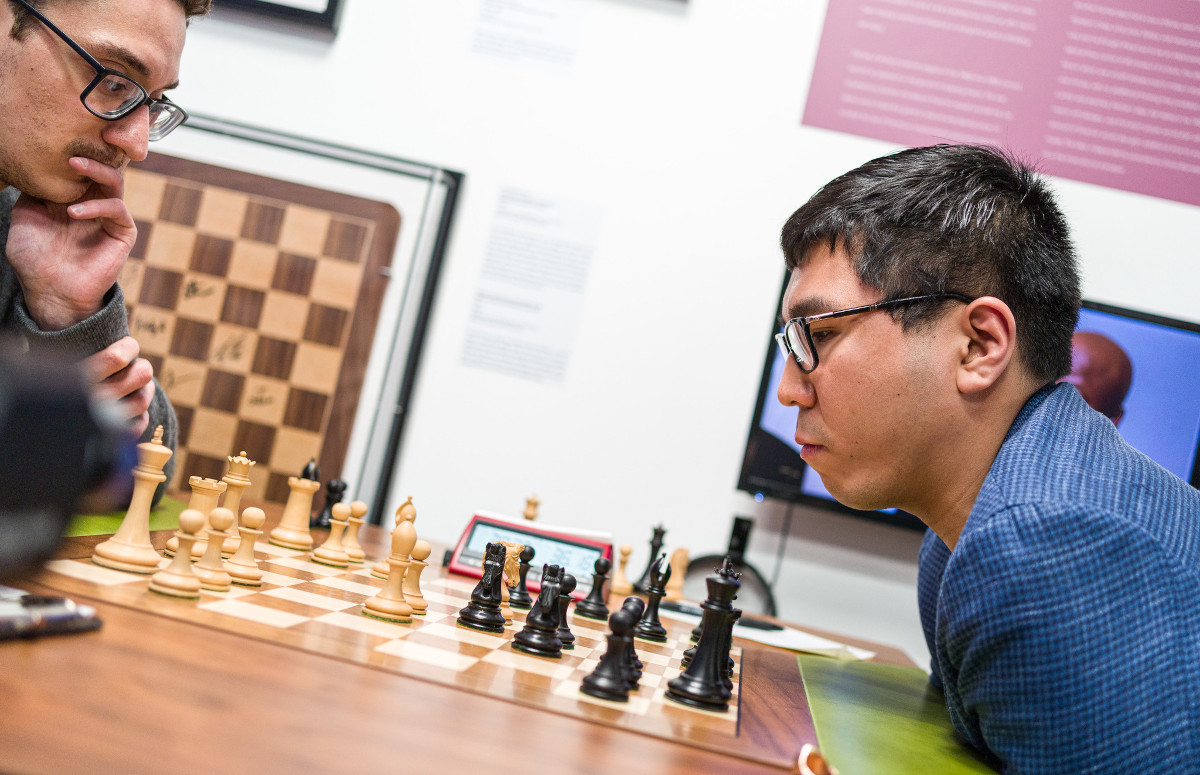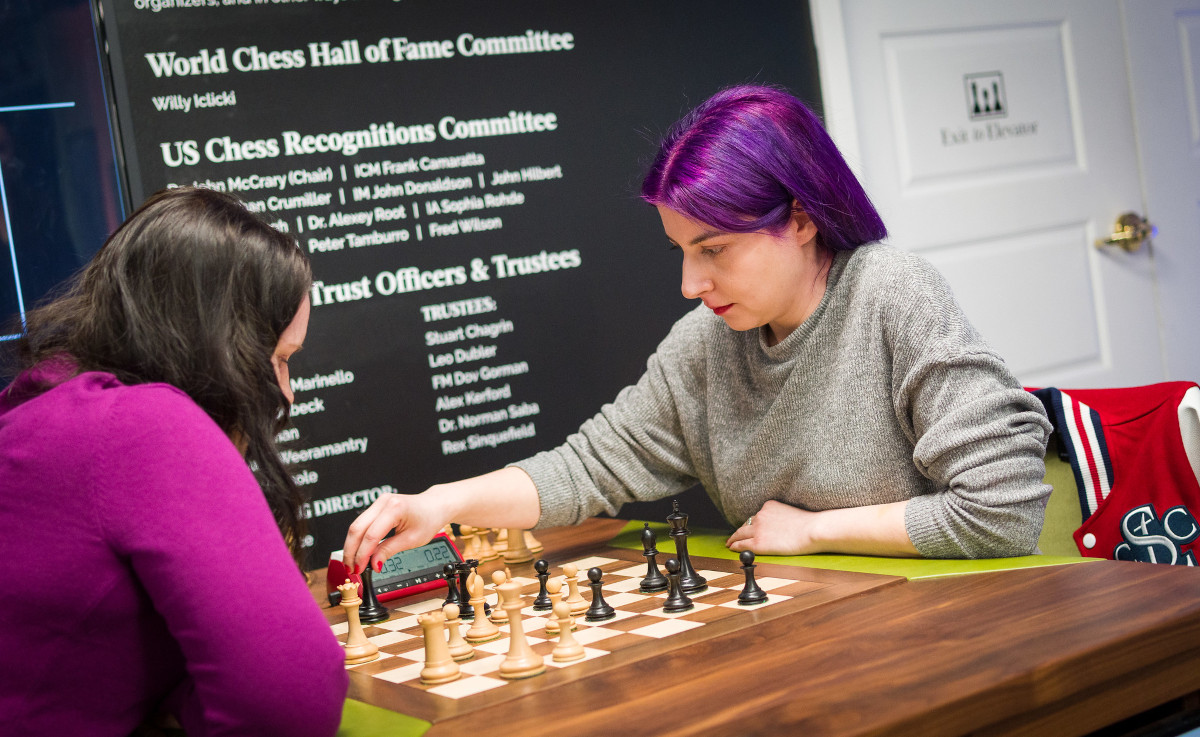Four players eliminated
By IM Kostya Kavutskiy / Saint Louis Chess Club
Day 3 of the American Cup saw four players eliminated from the tournament, as the first matches of the Elimination Bracket took place. Aronian knocked out Sevian, while Shankland won a hotly contested playoff against Robson. Meanwhile, in the women’s section, Abrahamyan took down Nemcova, while newcomer WGM Atousa Pourkashiyan sent Zatonskih home with a 1½-½ victory.
In this unique double-elimination format, the losers of each match get relegated to the Elimination Bracket, where they get a second chance to continue the tournament.
Open section - Champions bracket
Nakamura - Dominguez | ½-½, 52 moves
 This Najdorf-DVD is suited for the beginner as well as experienced club players. Pelletier presents a classical repertoire that's easy to learn and covers all you need to know about the Najdorf.
This Najdorf-DVD is suited for the beginner as well as experienced club players. Pelletier presents a classical repertoire that's easy to learn and covers all you need to know about the Najdorf.Facing a Petroff Defense, Nakamura opted for a line (4.Nd3) where the queens were exchanged quickly, taking the players to an endgame. Dominguez was under some pressure, but Nakamura missed his chance (27.b5) to maximize his advantage, instead choosing to trade bishop for knight in order to spoil the opponent’s structure. But Dominguez defended well, and the players eventually ended up in a drawn king and pawn endgame.

Hikaru Nakamura had a small advantage, but would have to settle for a draw | Photo: Saint Louis Chess Club / Lennart Ootes
Caruana - So | ½-½, 28 moves
After playing a somewhat rare variation against So’s Queen’s Gambit Accepted, Caruana found an early chance to play a thematic Nd5 sacrifice, looking to open up the e-file. However, So was able to decline the sacrifice without compromising his position, after which Caruana did not have anything better than to trade off several pieces, soon resulting in a drawn endgame.
Caruana’s 12.Nd5!? was quite shocking, yet calmly met with 12…Nbd7

A balanced draw in Game 1 | Photo: Saint Louis Chess Club / Lennart Ootes
Select an entry from the list to switch between games
Open section - Elimination bracket

Aronian - Sevian | 1½-½
In the first rapid game, the players reached a thematic middlegame from the Berlin Defense, where Sevian started to advance his kingside pawns without castling. But Aronian neutralized Sevian’s initiative well, sacrificing an exchange for tremendous compensation. Sevian soon had to give up his queen for two rooks, after which his king was still too exposed to survive, with Aronian converting in the endgame.
In the second game, Sevian managed to win an exchange in an endgame, and had definite winning chances. But the position was never straightforward, and after some precise defense Aronian managed to trade off all the pawns and force a draw, winning the match.

Levon Aronian wins the first game | Photo: Saint Louis Chess Club / Lennart Ootes
Shankland - Robson | 3½-2½
In what was the longest match of the day, Shankland and Robson drew the first pair of rapid games (25+10), each missing their chances as White, taking the match to a playoff. In the next set of rapid games (10+5), Robson drew first blood, winning a nice endgame where his passed pawns decided matters. But in the second game, Shankland struck back, defeating Robson in a Berlin Endgame and continuing the playoff.
58.Rxa6! forced resignation on the spot.
 Wesley So published two new opening DVDs: 1.b3, the so called Nimzo-Larsen-Attack, for White and his black secrets in the modern Italian. Get them in a package and save money!
Wesley So published two new opening DVDs: 1.b3, the so called Nimzo-Larsen-Attack, for White and his black secrets in the modern Italian. Get them in a package and save money!Going into the next set of blitz games (3+2), the first game was drawn as Shankland managed to hold as Black in a Najdorf. In the next game, Shankland opted for the Spanish Exchange and once again traded queens right out of the opening. Robson wasn’t able to generate sufficient counterplay on the queenside, and eventually Shankland was able to force his kingside pawns through.

A dramatic playoff where Sam Shankland emerged on top | Photo: Saint Louis Chess Club / Lennart Ootes
Select an entry from the list to switch between games
Women’s section - Champions bracket
Krush - Tokhirjonova | 1-0, 58 moves
Continuing her perfect streak, Krush managed to win her third straight game in the competition, defeating Begim in clean positional fashion. In an unusual line of the Queen’s Gambit Accepted, Tokhirjonova sacrificed her b-pawn with 7…Nbd7. Krush accepted the pawn and slowly nursed her advantage, trading off several minor pieces. The players eventually ended up in a queen and bishop vs. queen and knight endgame, with Krush’s passed b-pawn deciding the day.
After 42.Qg3+-, White had everything under control.

Irina Krush is the only player to start 3-0 | Photo: Saint Louis Chess Club / Lennart Ootes
Lee - Paikidze | ½-½, 70 moves
In a long struggle that started out as a Closed Benoni, both players missed some chances in the endgame. First it was Paikidze who held some edge, with the more active pieces and better pawn structure. After some trades, the players then reached a bishop ending, where Lee missed a golden opportunity to squeeze out a win. From there, Paikidze defended accurately and a draw was eventually reached.
39.exf5 gxf5 40.g5! would have given Lee a decisive advantage, as she could make a passed pawn on both sides of the board. Instead the game continued 39.gxf5 and was later drawn.

A draw in the first game of the match | Photo: Saint Louis Chess Club / Lennart Ootes
Select an entry from the list to switch between games
Women’s section - Elimination bracket

Abrahamyan - Nemcova | 2-0
In the first rapid game, Abrahamyan managed to create a strong passed pawn on the queenside, forcing Nemcova to search for kingside counterplay. An incredibly hectic time scramble ensued, where Nemcova did have chances to win, but failed to finish it off as Abrahamyan’s king made its way up the board. Eventually both sides were about to promote a second queen but Abrahamyan promoted first and would force resignation due to mate next.
 In a total of 6 chapters, we look at the following aspects: the right decision based on tactical factors, decisions in exchanges and moves, complex and psychological decisions in longer games and in defence.
In a total of 6 chapters, we look at the following aspects: the right decision based on tactical factors, decisions in exchanges and moves, complex and psychological decisions in longer games and in defence.Final position of Game 1.
In the second game Nemcova tried to bounce back as Black, opting for the Scandinavian Defense. She managed to secure a pleasant knight v bishop middlegame, but eventually faltered in the endgame, allowing Tatev to turn things around and also win the second game.

An absolute roller-coaster of a game | Photo: Saint Louis Chess Club / Lennart Ootes
Pourkashiyan - Zatonskih | 1½-½
The first rapid game featured an ultra-solid line of the Nimzo-Indian, where Zatonskih played an early h4 advance, intending to attack Black’s king. However, Black’s queenside counterplay was sufficient, not giving White time to develop an initiative. The pieces were soon traded and the players would later draw in a rook endgame.
In the second game, Pourkashiyan played White and did not get much out of the opening against Zatonskih’s French Defense. The players then went into an endgame, where Pourkashiyan started to take over thanks to her powerful rooks and dark-squared bishop. Zatonskih was not able to hold on, and Pourkashiyan converted with excellent technique, winning the match.
27.f6!? posed significant problems to Black, as White followed up with doubling her rooks on the f-file.

With an excellent endgame win, Atousa Pourkashiyan knocked out the 4-time U.S. Champion | Photo: Saint Louis Chess Club / Lennart Ootes
Select an entry from the list to switch between games
Links

































